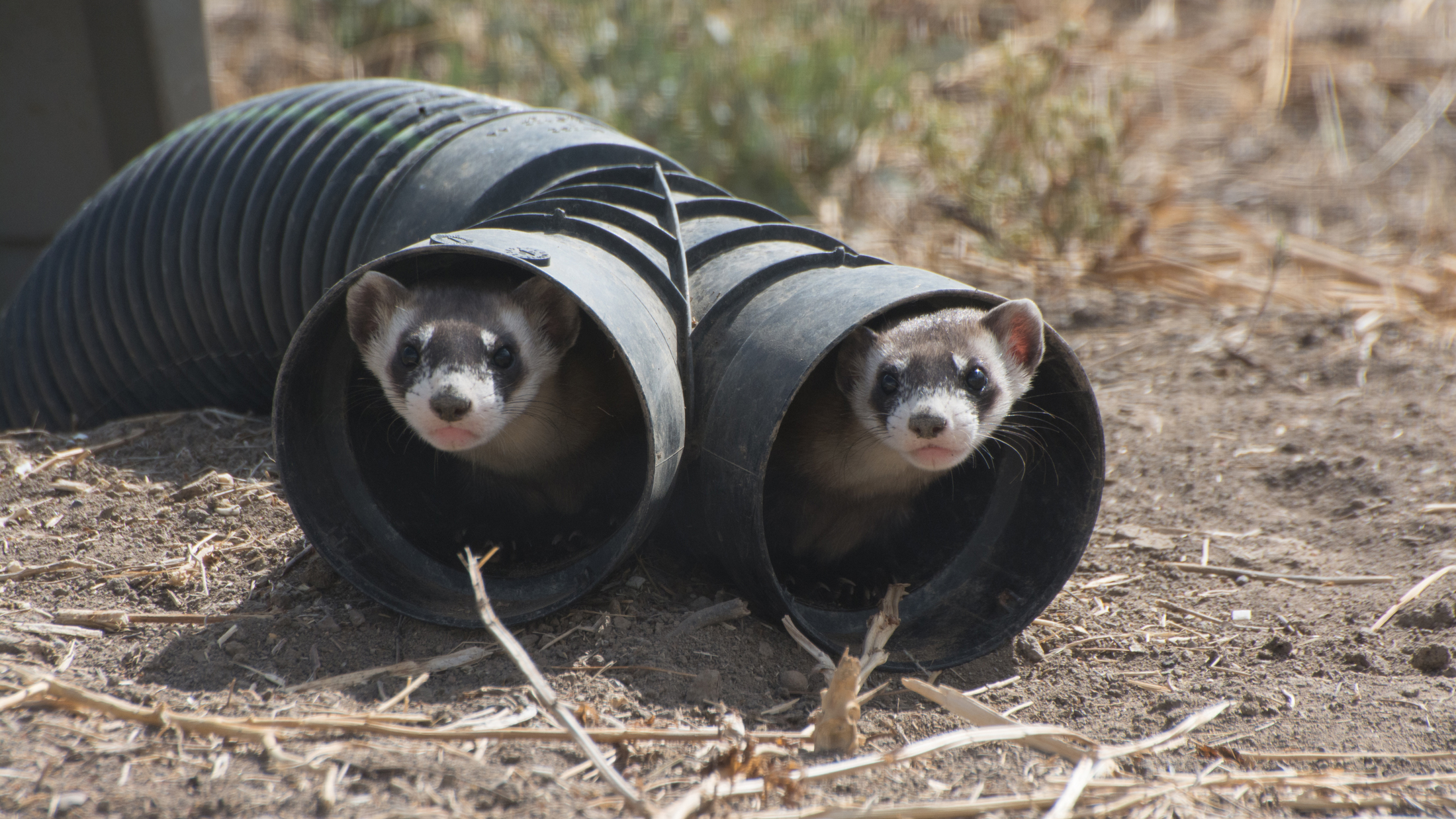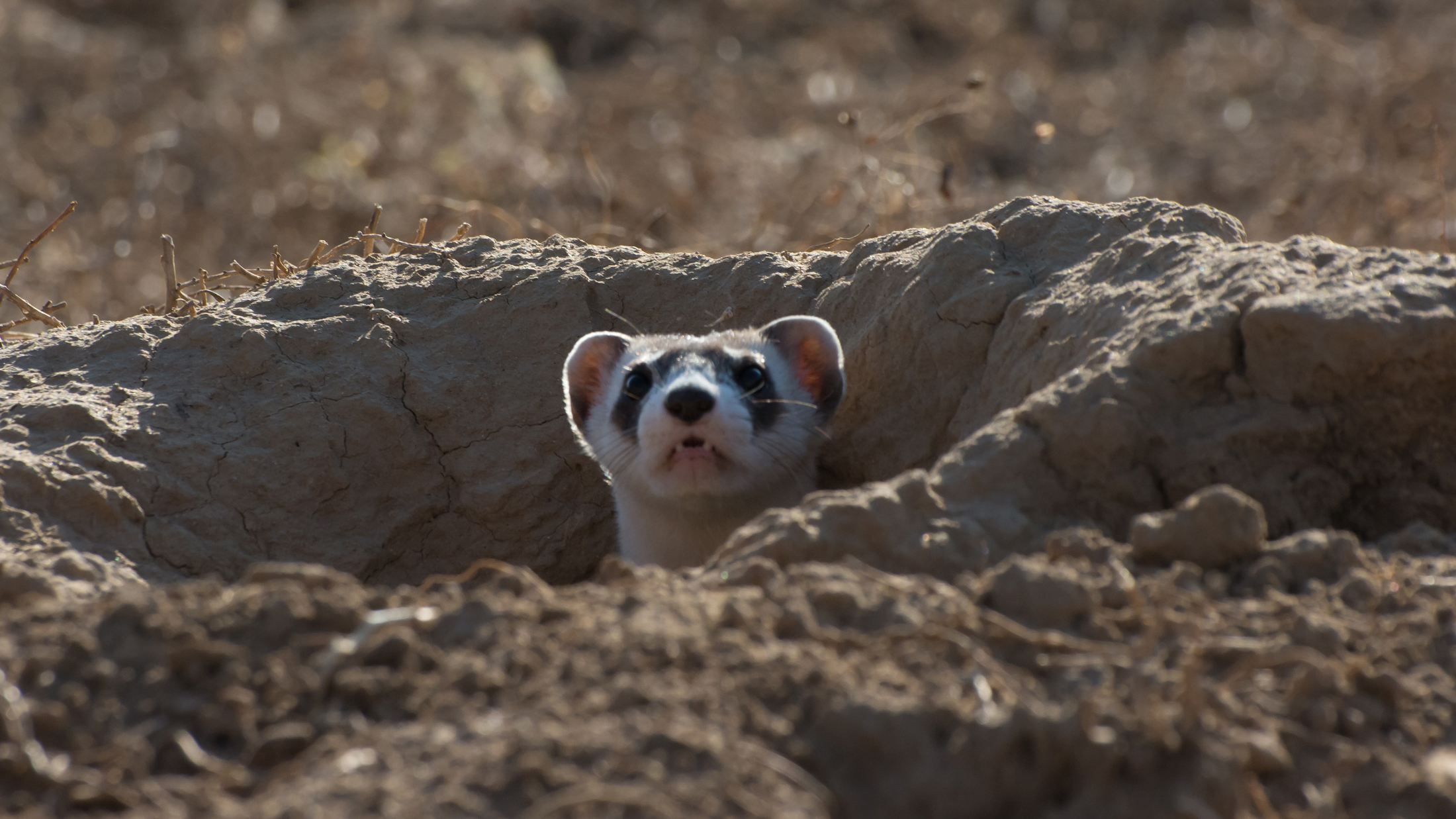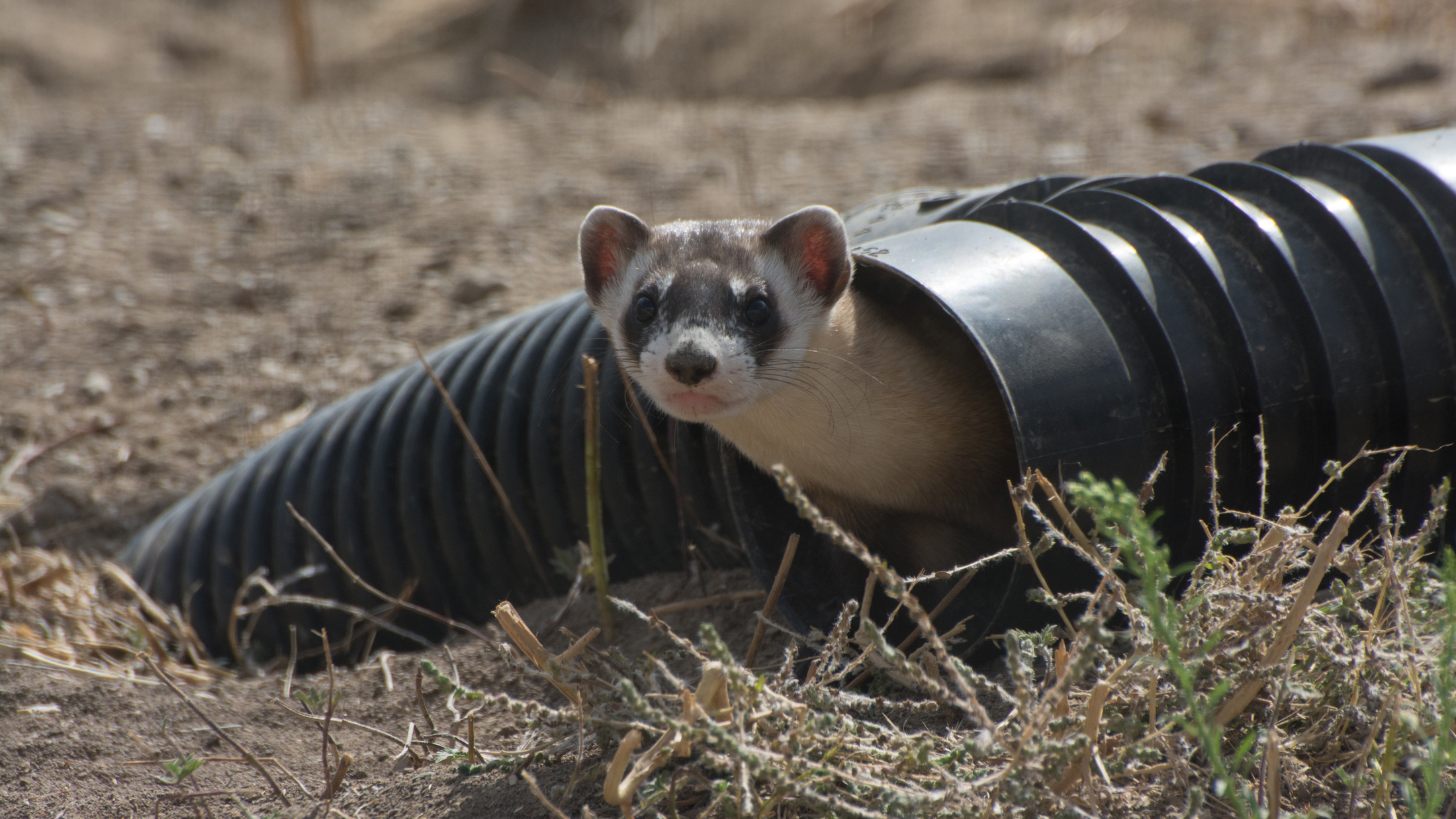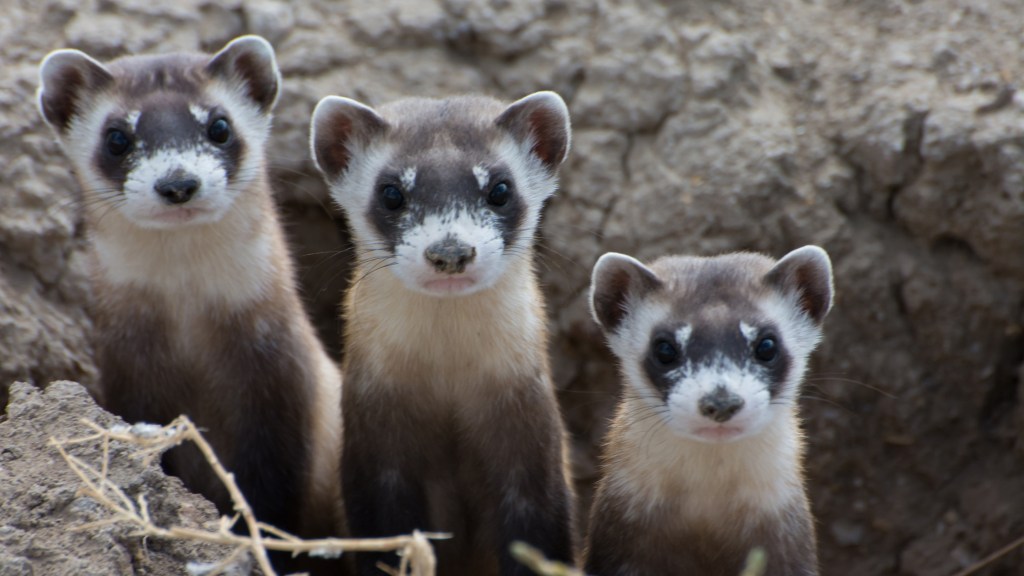In September 1981 an investigator in Meeteetse, Wyoming disproved the common knowledge that the black-footed ferret was extinct by collecting (i.e., killing) one. The investigator’s name was Shep. He was a dog.
For most of the ensuing 34 years recovery of the species seemed unlikely. No longer.
The Meeteetse ferrets were beset by canine distemper and bubonic plague (sylvatic plague, as it’s called in the wild), a flea-borne bacterial disease from Asia that arrived on the West Coast with stowaway rats circa 1900. So beginning in 1985 the Wyoming Game and Fish Department and the U.S. Fish and Wildlife Service evacuated 18 survivors in order to breed them in captivity. The first six captives died. The wild colony flickered out.
This wasn’t the first rediscovery of the black-footed ferret. In 1971 the Fish and Wildlife Service captured nine in South Dakota, killing four with attenuated-live-virus canine distemper shots to which, it thereby learned, the species is highly sensitive. All nine eventually died. Five kits delivered by one female died, too.
Rescued to Death? Not Quite.
So the Meeteetse evacuation was generally condemned by the environmental community, myself included. Ferrets, we charged, were being “rescued to death.” If the managers had listened to us, black-footed ferrets would indeed be extinct.
In the March 1986 Audubon magazine sent me to Wyoming to do a piece it called “The Final Ferret Fiasco.” Ferrets are susceptible to human diseases; so at the Game and Fish Department’s Sybille Wildlife Research Unit state veterinarian, Tom Thorne, and I sloshed our feet in green antiseptic, showered, strapped on surgical masks and donned plastic bathing hats, rubber sandals and blue jumpsuits. Inside the cement-lined ferret room a young male tensed in a wood-and-wire cage, fixed us with bright eyes, then dove into a drain pipe that mimicked a prairie dog burrow. He was big for the species, but I hadn’t expected ferrets to be so small. Or so beautiful. “Watch now,” said Thorne. “He’ll pop his head back out and look at us.” He did.

Captive breeding, initiated the following year, proved successful. But with only eight fertile animals, managers feared that inbreeding would doom the species. The search for a second wild population has been exhaustive, but to date no ferret without Meeteetse lineage has been reported.
The Prairie Dog Connection
At least 150 vertebrates benefit from prairie dogs. The black-footed ferret, which preys on prairie dogs and inhabits their burrows, can’t live without them. Unfortunately for ferrets, most ranchers hate prairie dogs. Property owners and sometimes even the feds in some states are required by law to poison them if they encroach on neighboring land.
Prairie dogs clip grass so they can see predators, but plants that grow around their excavations are especially nutritious. Every prairie dog town I encountered in South Dakota’s Conata Basin was littered with cows or cow pies. The grass was low but very green. All around me were grassy hills devoid of cows and prairie dogs. No one forced the cows down into the dog towns. They knew something the ranchers didn’t.

That’s not to say that prairie dogs are never a problem for ranchers. Veteran ferret researcher Dr. Dean Biggins of the U.S. Geological Survey, offers this: “The debate about prairie dogs is complicated because they eat some of the same things cows do. There are positives and negatives. I can understand attitudes of the ranching community; there’s got to be competition during drought years. But counterbalancing effects should be considered, too.” He went on to explain that prairie dogs increase fertility by bringing moist, nitrogen-rich soil to the surface.
Plague is an even bigger threat to ferrets than the war on prairie dogs.
Dr. Pete Gober, the Fish and Wildlife Service’s black-footed ferret recovery coordinator, estimates the number of ferrets on the 27 release sites initiated to date at between 200 and 300. “Just a few years ago we had twice that many,” he says. “But drought and plague knocked us back. In dry years ferrets have a hard time finding food for their kits; and in wet years plague-carrying fleas proliferate.”
Where plague occurs the only hope has been an injectable and therefore impractical vaccine for the ferrets and the insecticide deltamethrin to kill the fleas that spread plague to ferrets and prairie dogs. But now fleas are building resistance.
Hope for Ferrets
So where’s the good news? Some of it includes a bait-delivered plague vaccine for prairie dogs developed by the USGS. A three-year field trial has just wrapped up; and while the researchers aren’t talking until their final report is ready, Gober says this: “It’s pretty obvious when you look at a treatment site and a control site. The treatment site has prairie dogs; the control site doesn’t.”

So far there’s no sign of ferret inbreeding. In release sites where prairie dogs thrive and plague doesn’t, ferrets reproduce very rapidly and with no evidence of disability. And, while a second population of wild origin has yet to turn up, genetic diversity has gotten a major boost by artificial insemination with frozen sperm from original Meeteetse animals.
The recent decline in released ferrets is less important than one might suppose. Captive breeding produces somewhere between 125 and 250 animals a year. “We can replace the ferrets,” declares Gober. “What we can’t replace is willing landowners.”
Until 2013 willing landowners were hard to find. But that year the Fish and Wildlife Service implemented a “Safe Harbor” program by which the agency promises not to prosecute participants for accidental take of ferrets if they agree to protect prairie dogs and allow ferret monitoring and plague management. What’s more, in some states the Natural Resources Conservation Service pays them for hosting ferrets. Without Safe Harbor the Endangered Species Act tends not to work on private land; and without private land ferret recovery can’t happen.
In Colorado Safe Harbor already has allowed ferret releases on five private sites, the first on the Walker ranch near Pueblo. Fourteen years ago Gary Walker’s horse stepped in a prairie dog hole and landed on him, crushing his rib cage and breaking his back, arm and collar bone.
“I have plenty of reason to hate prairie dogs,” says Walker. “I don’t. They can be a terrible nuisance; but I don’t believe in poisoning, and there aren’t enough bullets in the world to eliminate them. In 1995 we had about 3,000 acres of prairie dogs. By the time I got ferrets [in 2013] we had almost 10,000 acres. I prefer to let natural predation contain my prairie dogs. That’s why we wanted ferrets.”
Helping ferrets with prairie dog containment on the Walker ranch is a profusion of swift foxes, badgers, coyotes, bobcats, hawks, owls and golden eagles — all vulnerable to secondary mortality by the popular prairie dog poison Rozol.
I spoke with Walker in early November, hours after he’d met with The Nature Conservancy in order to grant it a 6,360-acre conservation easement. That will push TNC easements on his ranch to about 30,000 acres and go a long way to securing a future for black-footed ferrets. “TNC fights the good fight,” Walker told me. “We’re always here to help them; and I hope they’ll always be here to help us.”

Under the Fish and Wildlife Service’s new recovery plan ferrets will be taken off the Endangered Species list if, among other criteria, a captive breeding population is maintained at a minimum of 105 males and 175 females at three or more facilities and at least 3,000 breeding adults are extant in 30 or more wild populations in at least 9 of the 12 states within the original range.
Gober feels lots better about the future of black-footed ferrets now than when I last interviewed him, almost a decade ago. “We know our objectives,” he says. “We know the tools we need. Whether or not we’ll get the resources for that level of management is the question.”
Recovery will require about 500,000 acres of healthy prairie dogs. Given the current level of interest and commitment, Safe Harbor and the new plague vaccine, that’s an eminently attainable goal. It’s also a modest one, considering that 500,000 acres is about a tenth of one percent of historical habitat.
This is the latest in a series called “Recovery” written by Ted Williams. He writes about fish and wildlife for national publications.




good job 🙂
I have domesticated ferrets so I’m very interested in the well-being for their wild cousins 🙂
Thank you for making the connection between ferrets and prairie dogs, and how we need to also protect the food source for ferrets. I’m grateful that rancher Gary Walker has an evolved way of viewing prairie dogs, and not archaic beliefs that prairie dogs are harmful and should be poisoned. They need to be saved just as much as the ferret. In Fort Collins, Colorado a group of volunteers have relocated urban prairie dogs out of harms way (development). In Wellington, Colorado there is a breeding program for ferrets. We’re hopeful we can turn the “pest” label around to where people understand the importance of these animals to the grasslands. It would be cheaper to compensate ranchers and farmers for the loss of weight their cows allegedly experience when “competing” for grass, or if they step in a hole, than it costs to poison a keystone species and the other species that rely on prairie dogs for food and their burrows for shelter and nesting.
Great news for black-footed ferrets:
http://gazette.com/anonymous-1-million-gift-lets-zoo-rebuild-critical-conservation-center/article/1567232
Just another great example of how one species contributes to biodiversity and bennefits the overall health of the environment.